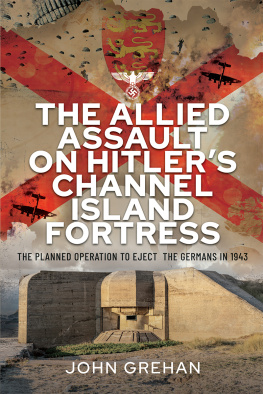First published in Great Britain in 2015 by
Pen & Sword Military
an imprint of
Pen & Sword Books Ltd
47 Church Street
Barnsley
South Yorkshire
S70 2AS
Copyright Martin Mace and John Grehan, 2015
ISBN: 978 1 78346 2 322
EPUB ISBN: 978 1 47386 2 685
PRC ISBN: 978 1 47386 2 678
The right of Martin Mace and John Grehan to be identified as Authors of this Work
has been asserted by them in accordance with the Copyright, Designs and Patents
Act 1988.
A CIP catalogue record for this book is available from the British Library.
All rights reserved. No part of this book may be reproduced or transmitted in any
form or by any means, electronic or mechanical including photocopying, recording
or by any information storage and retrieval system, without permission from the
Publisher in writing.
Printed and bound in England
By CPI Group (UK) Ltd, Croydon, CR0 4YY
Pen & Sword Books Ltd incorporates the Imprints of
Pen & Sword Aviation, Pen & Sword Family History,
Pen & Sword Maritime, Pen & Sword Military, Pen & Sword Discovery, Pen &
Sword Politics, Pen & Sword Atlas, Pen & Sword Archaeology, Wharncliffe Local
History, Wharncliffe True Crime, Wharncliffe Transport, Pen & Sword Select, Pen &
Sword Military Classics, Leo Cooper,
The Praetorian Press, Claymore Press, Remember When,
Seaforth Publishing and Frontline Publishing.
For a complete list of Pen & Sword titles please contact:
PEN & SWORD BOOKS LIMITED
47 Church Street, Barnsley, South Yorkshire, S70 2AS, England
E-mail:
Website: www.pen-and-sword.co.uk
INTRODUCTION
The Germans invaded Norway on 9 April 1940, pre-empting Allied plans to prevent Germany access to the iron ore mines at Gllivare in the north of the country. Consequently, by the time that Lieutenant General H.R.S. Massy was appointed Commander-in-Chief, North West Expeditionary Force on 19 April, German forces were already well established in Norway. However, as the Germans had not penetrated far into the north in great strength, there was still a chance of stopping them before they had achieved complete control of the country.
Trondheim was seen as the gateway to the north and had been seized by the Germans. Massy was instructed to take it. In his despatch submitted to the War Office, Massy declared that as a first step his intention was to stop the German advance from Oslo, before then planning a deliberate combined operation for the capture of Trondheim itself.
He informed the Chiefs of Staff that any possibility of landing further troops or of maintaining the troops that had already been landed depended entirely on achieving air superiority. With control of the air, Massy believed that his forces could indeed hold back the Germans. Without it he was certain that further operations would be impossible and that the British forces would be compelled to withdraw from southern and central Norway. He would, of course, be proven correct.
The first problem that Massy had to deal with was the precarious situation which Major-General Carton de Wiart faced at Namsos to the north of Trondheim. His combined Anglo-French force was already under heavy aerial and artillery bombardment and, according to de Wiart, could not hold out for much longer.
Attempts at landing Gloster Gladiator fighters on the frozen Lake Lesjaskog failed, as did a further effort at landing them at a shore-based aerodrome. This meant that the Allied troops had no protection from the Luftwaffe. The entire Norwegian operation was doomed to failure.
As the campaign in Norway was a brief affair Massy was able to provide a detailed account of the fighting and, what became the most crucial aspect of the operation, the withdrawal of the Allied forces. That this was achieved with any degree of success was due in no small measure to the arrival of aircraft carriers in theatre. The Germans would not face our Fleet Air Arm fighters, Massy wrote, which were handled with a boldness that was an inspiration to the troops who watched their manoeuvres from the ground.
Apart from the efforts of the Fleet Air Arm, the Royal Navy also engaged the Kriegsmarine on 10 April, the day following the German invasion, at Narvik, in the Ofotfjord to the far north of Norway, within the Arctic Circle. A report on the battles there on the 10 and then on 13 April, are the subject of the second despatch in this volume.
German naval forces were spotted in Ofotfjord by the commander of the Royal Navys 2nd Destroyer Flotilla, Captain Bernard Warburton-Lee. Norwegians report Germans holding Narvik in force also 6 destroyers and 1 submarine are there and channel is possibly mined. Warburton-Lee informed the Admiralty, and in true Nelsonian style, concluded his brief signal with the simple sentence, Intend attacking at dawn, high water. No permission to attack was asked or further instructions were sought and at dawn he launched his attack.
Warburton-Lee did not survive the battle and his award of the Victoria Cross was the first to be gazetted in the Second World War. The despatch on the First Battle of Narvik was compiled by the senior surviving officer, Commander H.F. Layman, and Lieutenant-Commander R.E. Courage.
The second battle at Narvik, fought on 13 April 1940, is described by Vice-Admiral W.J. Whitworth. This was an entirely different affair with a much stronger force being deployed, including the battleship HMS Warspite and the aircraft carrier HMS Furious. In his report Whitworth claimed that all eight German destroyers and the submarine present at Narvik had either been sunk or scuttled, though at the time Whitworth did not know that there was a second submarine in the port which survived the engagement.
In his despatch Whitworth made the following observation: I am convinced that Narvik can be taken by direct assault now without fear of meeting serious opposition on landing. As a result of this information it was decided to quickly attempt to land troops and seize Narvik before the Germans could reinforce their units in that area.
A plan to capture Narvik had already been put in motion but following the receipt of Whitworths report, it was decided to move against Narvik as soon as possible. Consequently, William Henry Dudley Boyle, Admiral of the Fleet the Earl of Cork and Orrery, who was to lead the expedition, was instructed to attack Narvik without delay.
The small German garrison in Narvik was supplemented by the sailors from the ships that had been destroyed, bringing the total force up to around 5,000 men. French, Norwegian and Polish troops were sent to strengthen the British contingent until there were in excess of 24,000 men deployed.
Despite their numerical disadvantage the Germans held out until the second week of May. The sudden German attack upon France and the Low Countries on 10 May changed the strategic situation completely and attention was diverted away from Norway to the Battle of France.
Events moved very rapidly over the course of the next few days and as the British Expeditionary Force in Belgium retreated towards the Channel ports, the following signal was sent to Admiral Boyle: His Majestys Government has decided your forces are to evacuate Northern Norway at earliest moment. Reason for this is that the troops, ships, guns and certain equipment are urgently required for defence of United Kingdom. We understand from military point of view, evacuation operations will be facilitated if enemy forces are largely destroyed or captured. Moreover, destruction of railways and Narvik port facilities make its capture highly desirable. Nevertheless, speed of evacuations once begun should be of primary consideration in order to limit duration maximum naval efforts.















